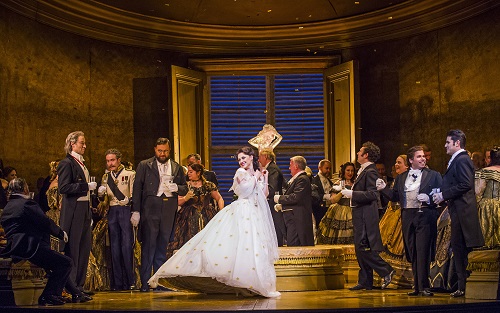 United Kingdom Verdi, La traviata: Soloists, Chorus and Orchestra of the Royal Opera House, Covent Garden/Yves Abel (conductor), Royal Opera House, Covent Garden, London, 16.01.2016. (CC)
United Kingdom Verdi, La traviata: Soloists, Chorus and Orchestra of the Royal Opera House, Covent Garden/Yves Abel (conductor), Royal Opera House, Covent Garden, London, 16.01.2016. (CC)

Directed by Richard Eyre. Conductor Yves Abel ©Tristram Kenton
Cast:
Violetta Valéry: Venera Gimadieva
Alfredo Germont: Samuel Sakker
Giorgio Germont: Luca Salsi
Flora Bervoix: Andrea Hill
Marquie d’Obigny: Jeremy White
Baron Douphol: Yuriy Yurchik
Doctor Grenvil: James Platt
Gastone de Letorières: Luis Gomes
Annina: Sarah Pring
Messenger: John Bernays
Servant: Michael Lessiter
Production:
Director: Richard Eyre
Revival Director: Daniel Dooner
Designer: Bob Crowley
Lighting Designer: Jean Kalman
Movement Director: Jane Gibson
This is the stuff from which legends can emerge: the Albanian tenor Saimir Pirgu was forced to retire from this first performance of the ‘A’ Cast at the eleventh hour due to a throat infection. (Cast ‘B’ starts from March 1). In stepped Australian tenor and Jette Parker Young Artist Samuel Sakker, who joined the Jette Parker scheme in 2015. Fresh from rehearsing Patacha (Chabrier L’Étoile), he then had to make his way through the demanding part of Alfredo. He is set to perform Heinrich der Schreiber in Tannhäuser later in the season, as well as Gastone in the February and March performances of this Traviata.
Sakker, perhaps understandably, looked absolutely terrified at his first entrance, with gestures to a minimum. His voice underlined this impression, rather bleaty and initially not totally under control. In the Act I duet “Un di felice”, his contributions suffered from lack of the long line. It seems churish to moan, given the circumstances, though, and as the performance progressed, so Sakker’s confidence increased. His actual vocal contribution to the second act was far finer as confidence crept in, although there was still a feeling of stand-and-deliver to it all.
By far the shining light of this Traviata was Russian soprano Venera Gimadieva, making her Covent Garden debut in the role of Violetta Valéry. My colleague Jim Pritchard reviewed a simulcast of the 2014 Glyndebourne production that featured her here (she has also taken the role at the Bolshoi, Limoges, Savonlinna, La Fenice and the Paris Opéra, so her experience with the part is vast). Again, it rankles somewhat to state that whenever Alfredo stopped singing in Act I and Violetta started singing, the performance went up a league or two, but such was nevertheless the impression. Gimadieva’s vocal gymnastics, her ultra-clean slurs and her simply beautiful phrasing conspired to create an excellent Violetta. Throughout the performance Gimadieva strove to convey the utmost engagement with the part, be it in the second act exchanges or in her phenomenally involving “Addio del passato”. In the final stretches of the opera Violetta’s core spirit and strength was palpable; fittingly, Gimadieva found her very finest here.
The role of Germont père was taken by Luca Salsi, making his Royal Opera debut (he has sung Georgio at Monte-Carlo, the Paris Opéra, La Fenice, Turin, Genoa and Macerata, so he is no stranger to the role). His stage presence oozes a commanding demeanour; his voice is actually a little lighter than his presence might imply, yet his “persuasion” duet with Violetta was masterful, dramatically and vocally. He was more human, more yielding, than many Giorgios; his tone, too, in “pura siccome un angelo” was positively honeyed.
Of the smaller parts, Sarah Pring’s Annina was outstanding in every respect. Ukrainian baritone Yuri Yurchik, too, had great presence. James Platt was a perfectly acceptable Doctor Grenvil, Jeremy White a very experienced and confident Marquis d’Obigny and Canadian mezzo Andrea Hill was secure for her Royal Opera debut as Flora Bervoix.
The conductor, Yves Abel, set alarm bells ringing in the opening stages by a very fast tempo for the opening scene – so fast that the Violetta had a hard time keeping up. Yet things settled down – the light strings at the opening of the second act were perfectly judged, and accompaniments took on an urgency that underpinned the drama). Abel is not above a touch of string portamanto, either (the opening to the third act), and played as stylishly as this it seemed perfectly natural. The Royal Opera House Chorus was in fabulous form throughout, absolutely flawless and world-class in its contributions.
And so to the production, left to the last section of the review this time as it is the Covent Garden stalwart by Richard Eyre (ie the same one I reviewed in October 2011 and January 2012). The revival director is Daniel Dooner. Lighting designer Jean Kalman impresses in the way she can catch exactly the mood, from the glitter of Act I to the afternoon sunlight of the second act to the nocturnal tragedy of the last, underscoring the prevailing atmospheres, often subtly. The shadow play of the passing festivities in act III is likewise superbly managed.
Movement Director Jane Gibson does well working in tandem with the director to convey the claustrophobic side of the first act party; she triumphs similarly with the distorted stage perspectives of the gambling scene of Act II. Incidentally, was it my imagination, I wonder, or was the camp damped for the matadors in Act II?
The performance on February 4 2015 will be the cinema relay. (One assumes by this time Saimir Pirgu will be reinstated as Alfredo).
Colin Clarke
